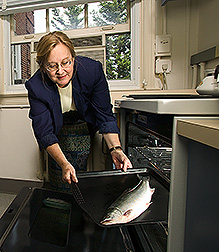|
Read the
magazine
story to find out more. |
|

Nutritionist Pamela
Pehrsson prepares an Alaskan Arctic char before nutrient analysis. The fish was
harvested in the Point Hope region of Alaska by Alaska Natives. Click the
image for more information about it.
|
Food Samples Travel Thousands of Miles for
Analysis
By Rosalie Marion Bliss
September 9, 2005
A database that lists the nutrient content of traditional foods
commonly eaten by American Indians and Alaska Natives is being developed by
Agricultural Research Service (ARS)
nutritionists and colleagues. To that end, Alaska Natives have been hunting and
fishing for foods that represent their daily fare--not to eat, but to be
shipped to ARS for nutrient analysis.
Brined salmon, caribou rump meat and bearded seal meat are just a few
of the samples being packed in dry ice and shipped from the Point Hope region
of Alaska to the ARS
Nutrient
Data Laboratory in Beltsville, Md. Other remote locations from which food
is being collected include the Ft. Hall ShoBan reservation in southern Idaho
and a large Navaho reservation in Arizona.
The project is coordinated by
Pamela
Pehrsson, a nutritionist with ARS' Nutrient Data Laboratory, and
colleagues.
The native foods that have already been analyzed are being added to a
comprehensive nutrient database of more than 7,000 foods. The database is
available on the Nutrient Data Laboratory website. The efforts will ultimately
fuel the USDA-ARS American Indian/Alaska Native Foods Database, a special
interest database that will be released as a stand-alone resource on the same
website in 2006.
The data for these unique foods are important for providing wider
representation within nationwide food consumption surveys, since dietary
practices among these communities differ from those of the general U.S.
population. As a result, the database will enable nutrition researchers to more
accurately assess nutrient intake within these populations. The data are also
important to the ability of health care workers to provide appropriate
nutrition guidance within native communities.
Read more
about this research in the September issue of Agricultural Research
magazine.
ARS is the U.S. Department of
Agriculture's chief in-house scientific research agency.